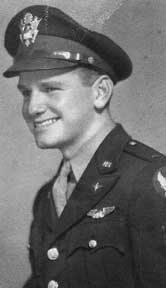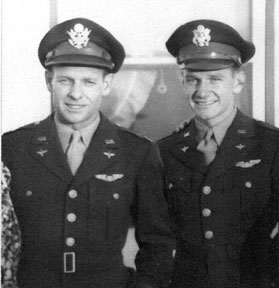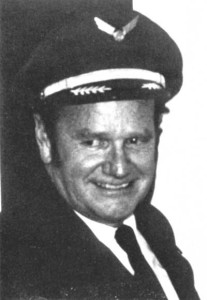 Flying Tiger Line Pilots Association
Flying Tiger Line Pilots Association
In Memoriam...
Ralph Flint Mitchell, Jr.
March 17, 1924- December 9, 1993
Ralph Flint Mitchell, Jr. was born in Dinuba, California, the youngest of six children. The Mitchell family was a pioneer family having come to California, via Vermont and Massachusetts, and from England in the early sixteen hundreds.
Ralph was destined to be a pilot although he studied geology at Fresno State University. Brothers, Hewitt and Dick, also served distinguished aviation careers in the Army Air Corps and Air Force. Hewitt flew in China for CNAC between 1933 and 1937 and was one of the first people to fly into the interior of China up the Yangtze River.
 Ralph’s flying career started when he reported to duty in the Army Air Corps in early 1943. He soloed on August 9, 1943 as an Aviation Cadet at the Cal-Aero Flight Academy, Ontario, California in a Stearman PT-17. After a transfer to Pecos, Texas for an experimental advanced training program, Ralph flew AT-6’s, BT-13’s, AT-17’s (also known as the UC-78 or “Bamboo Bomber”), and AT-9’s, ultimately moving on fly the multi-engine AT-24. The AT-24 was an advanced version of the B-25 bomber configured for training. Within months, Ralph transferred to more advanced flight training at La Junta, Colorado, for training on the B-25 “Mitchell Bomber.”
Ralph’s flying career started when he reported to duty in the Army Air Corps in early 1943. He soloed on August 9, 1943 as an Aviation Cadet at the Cal-Aero Flight Academy, Ontario, California in a Stearman PT-17. After a transfer to Pecos, Texas for an experimental advanced training program, Ralph flew AT-6’s, BT-13’s, AT-17’s (also known as the UC-78 or “Bamboo Bomber”), and AT-9’s, ultimately moving on fly the multi-engine AT-24. The AT-24 was an advanced version of the B-25 bomber configured for training. Within months, Ralph transferred to more advanced flight training at La Junta, Colorado, for training on the B-25 “Mitchell Bomber.”
On February 8, 1944, Ralph graduated as a Cadet and received his Air Corps silver wings and 2nd Lieutenant’s gold bars. Proud of his accomplishments, but disappointed that he was not assigned to fighters or bombers, Ralph was assigned to the 56th Squadron of the 375th Troop Carrier Command on C-47’s and DC-3’s. On July 5, 1944, Ralph took off for Nadzab, New Guinea and the Pacific theater via John Rogers Field (now Hickam AFB). The flight took 14 hours and 40 minutes. After stops at Christmas Island, Canton Island, Nandi in Fiji, Tontouta Airfield in New Caledonia, Ralph ended up in Port Moresby, New Guinea. Over the next thirteen months, Ralph flew throughout the Pacific theater ranging from Sydney, Australia to ultimately Tokyo, Japan. He fulfilled his Air Corps duties with honor.
As many pilots found after getting home after the war in late 1945, however, getting employment was not easy but Ralph’s perseverance carried the day. Ralph later wrote:
"I flew C-46s during WW II, but after the war I tried everywhere I could think of to get a flying job. I had no luck, so I went back to college for a year and a half. My oldest brother flew for CNAC in China in the early thirties. Ernest Allison, who was one of the early airmail pilots, was the chief pilot for CNAC. He did the hiring, so on a long shot I sent him my application. I figured if it didn't work out, I'd give up and become a geologist, which was what I was studying in college. I'd used my G.I. Bill to get my instrument rating and had just completed training when I received a large envelope from Shanghai, China. Mister Allison hired me on the strength of my brother's reputation, but I had to pay my own way to China. I bought a ticket on a cargo steamer for $270. I was the only passenger.
When the ship docked in Yokohama, the captain said, ‘We'll be here for three days, so have a good look around Japan but don't get lost.’
I had some friends who were living in Tokyo, so I went to visit them for a couple of days. I returned to Yokohama well before the scheduled departure time, but the ship was disappearing over the horizon. At this time Japan was controlled by the occupation forces, so one had to have a military pass to enter the country. I didn't have one, so the captain had given me a crew pass -- which was now illegal because I had no ship.
Pan American Airways owned half of CNAC at the time, so I went to their offices and told the manager of my plight. I asked him to wire Mr. Allison and ask him for a ticket from Tokyo to Shanghai, and also an advance on my salary. Mister Allison was king enough to grant my request, so I thought my troubles were over.
Then the manager said, "Let me see your passport."
When I handed it to him he said, "Where is the Military occupation authority permit? You need one to leave here."
I explained why I didn't have one, so because of the fact that there was no official record of my having entered Japan, I was allowed to leave the same way and finally arrived in Shanghai. Chinese immigration wasn't happy to see me either because I had no luggage and only 53 cents in my pocket.
I had to fly as copilot for about a month then flew as captain for the rest of my time in China. During the war with the Communists we flew in supplies for the Nationalists and brought refugees out on the return trips.
CNAC needed a few crews to fly out of Peking, so I was sent up there. I rented a very nice home with three servants. The only beds in the house were small single cots. King size beds had just become popular in the States, and I had one before I left. It was not possible to have one shipped over, so, Pong, my number one servant had one made for me in Peking. It was brass and cost about $300, which was an enormous amount of money at the time.
I was flying trips into Manchuria. As time went on the Communists kept gaining ground so the trips kept getting shorter as we had fewer and fewer places to go to. After about two months the company said we would have to pull back from Peking. It was about the end of 1948, and I was given only one day's notice, we had to evacuate the Chinese mainland in 1949 when the Communists took over.
After returning from China in 1949, Ralph obtained his US Air Transport Rating (ATR) and within months was off to fly for Ethiopian Airlines and stationed in Addis Ababa, Ethiopia. Many of the aircraft were C-46’s and DC-3’s from the war. The flying was throughout Africa, Europe, and Asia. Of note, the Emperor, Haile Selassie I, the “Conquering Lion of the Tribe of Judah, Elect of God, and King of Kings,” used an especially “plush” passenger plane of Ethopian Airlines as his private plane. Ralph was the Emperor’s preferred “first pilot” and flew the entourage often.
 On October 10, 1950, Ralph started work with the Flying Tiger Line, initially stationed in Denver again flying C-46’s. Between 1954 and 1955, he flew on the DEW line operations at 70 degrees north latitude across Canada to Baffin Island. The DEW line operations transported the equipment and personnel for the Early Distant Warning Line of radar, which were some of the original installations of the North American Air Defense System.
On October 10, 1950, Ralph started work with the Flying Tiger Line, initially stationed in Denver again flying C-46’s. Between 1954 and 1955, he flew on the DEW line operations at 70 degrees north latitude across Canada to Baffin Island. The DEW line operations transported the equipment and personnel for the Early Distant Warning Line of radar, which were some of the original installations of the North American Air Defense System.
Among many great memories for Tigers, Ralph was the last civilian pilot out of Saigon, South Vietnam in the events of April 18-22, 1975. On a volunteer basis, Ralph (with First Officers Ted Freedell and Second Officer Rick Middle) flew into Saigon during the very final days and hours before North Vietnamese occupation. Intelligence reports showed that SA-2 Russian anti-aircraft rockets within miles of Tan Son Nhut and expected there within hours. The operation was planned in secret to evacuate Tiger personnel, family and a number of others who contributors to Tiger’s Saigon operations, 108 in total. From Bangkok on the morning of April 20, 1975, Ralph landed at about 3:00pm. Filtering the passengers onto the airport in buses with windows blacked out, and then loading them into the aircraft in “igloos” under cover of darkness on at 9:01pm, Ralph flew them to safety to Manila that evening.
 Over his thirty-four year career with Tigers, Ralph flew DC-6’s, DC-6A’s, Lockheed L-1049H Constellation’s, 707’s, DC-8’s, and B747’s. His efforts through the Airline Pilots Association and otherwise led to developments in aviation safety and benefits.
Over his thirty-four year career with Tigers, Ralph flew DC-6’s, DC-6A’s, Lockheed L-1049H Constellation’s, 707’s, DC-8’s, and B747’s. His efforts through the Airline Pilots Association and otherwise led to developments in aviation safety and benefits.
On March 17, 1984, Ralph retired finishing his commercial pilot career with a round the world trip landing at San Francisco.
Outside his flying career, Ralph enjoyed the Mountains hiking in the Sierra, fishing, skiing and later in life playing golf. He was a patient, thoughtful, generous and a great Family man. He is missed dearly.
Back To Memorials